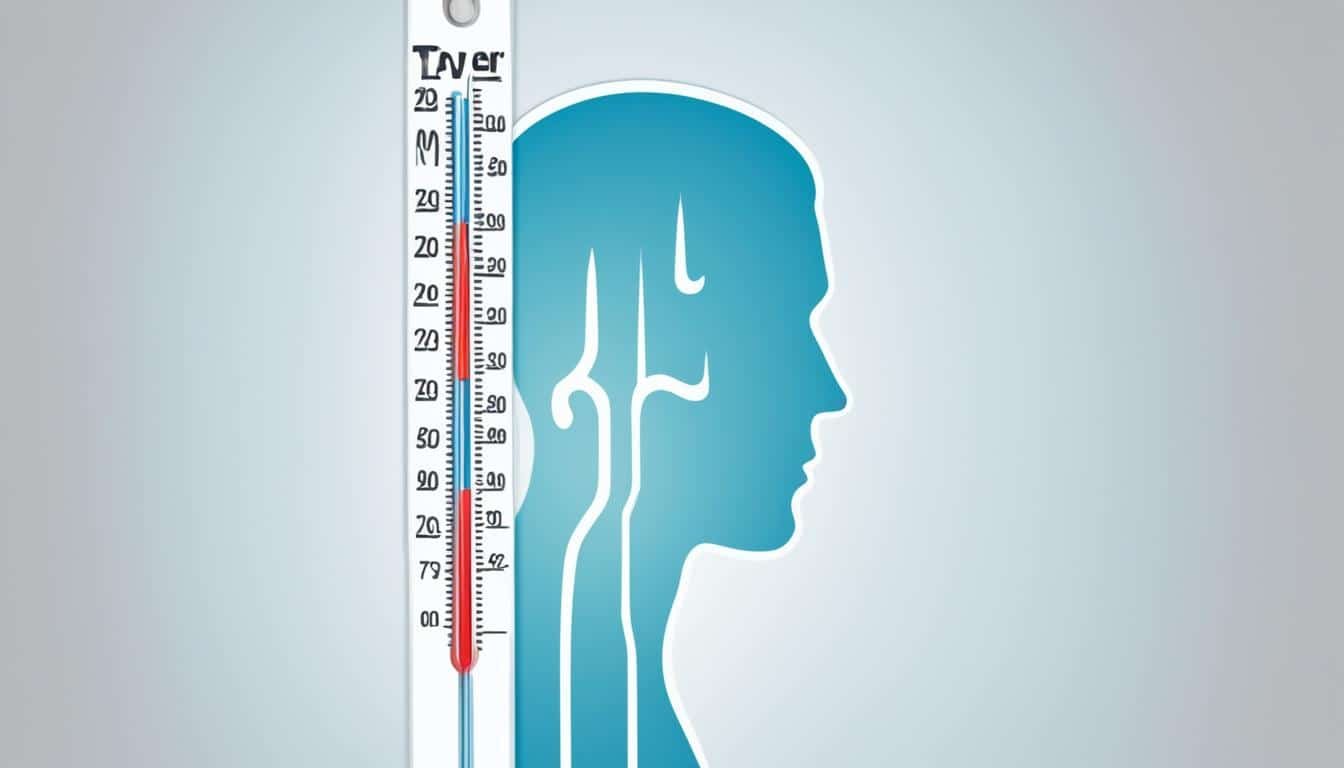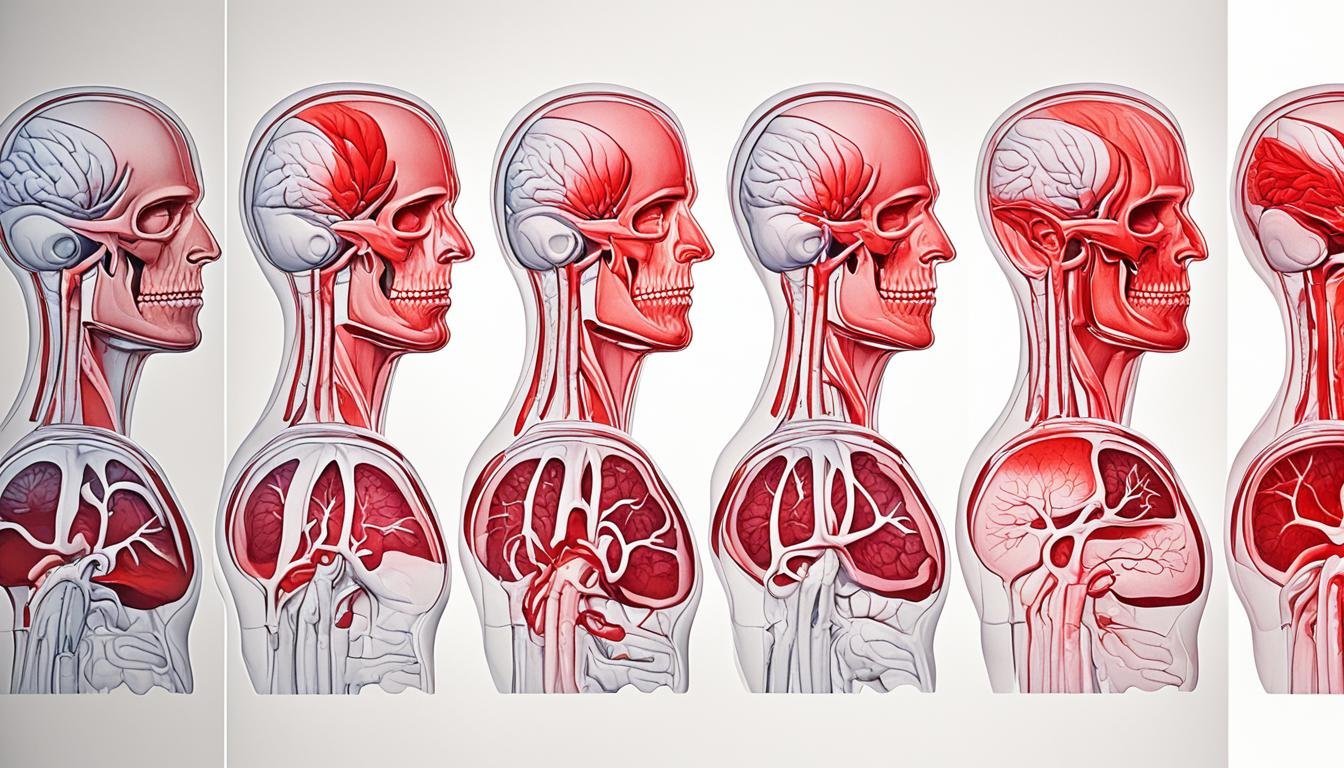A fever is when your body temperature goes up because of an infection. It’s usually not a big deal, especially for kids and adults. It often clears up on its own in a few days. But for babies, even a slight fever could mean something serious and they need to see a doctor.
When you get a fever, it means your body is fighting off an illness or infection. This rise in temperature helps your immune system get rid of the bad germs. It’s like your body’s way of saying, “Hey, I’ve got this!”
Key Takeaways
- Fever is a temporary increase in body temperature, usually caused by an infection.
- Fevers are generally not a cause for concern, especially in children and adults.
- Infants with even a low fever may require medical attention due to the potential for serious infection.
- Fever is the body’s natural response to fight illness or infection.
- Fever Symptoms Monitoring body temperature with a thermometer is important to determine if a fever is present.
Also Read : What Are The Early Symptoms Of Blood Cancer?
Understanding Fever
A fever is when your body temperature goes up. It happens when your immune system fights an infection or illness. This rise in temperature shows your body is trying to beat the sickness, whether it’s a virus, bacteria, or another condition.
Also Read : What Are The Top 10 TV Shows In The United States?
What is a Fever?
Usually, your body temperature stays between 97.5°F and 99.5°F. The average is about 98.6°F. A fever is when your temperature hits 100°F or higher. This means your body is dealing with something it can’t handle on its own.
Also Read : How Should I Prepare For A Video Interview?
Normal Body Temperature Range
Everyone’s normal body temperature is a bit different. It changes during the day too. Here’s what’s normal:
- Oral (mouth): 97.6°F to 99.6°F
- Rectal: 97.9°F to 100.3°F
- Axillary (armpit): 96.6°F to 98.0°F
- Tympanic (ear): 97.0°F to 100.0°F
Your body temperature changes all day. It’s usually lowest in the morning and highest in the late afternoon or early evening.
Also Read : What Are The Requirements For Obtaining A Master Degree?
“A fever is a sign that the body is working to fight off an infection or illness.”
Signs and Symptoms of Fever
Fever is a common response to illness. It often comes with symptoms that hint at the cause. Knowing these signs is key to spotting and treating fevers.
General Fever Symptoms
Common symptoms of fever include sweating, chills, and shivering. You might also feel headaches, muscle aches, lose your appetite, get irritable, dehydrated, and weak. These symptoms can change in intensity and last different lengths, based on the person and the illness.
Also Read : What Are The Interview Tips For Success?
Symptoms in Babies and Children
Babies and kids may show signs like earache, high-pitched cries, more thirst, and less urine. These signs are especially worrying in young kids. They might mean a serious illness is present.
Spotting and treating fever symptoms early can ease discomfort and stop complications. By knowing the common signs of fever, people can watch their health closely. They can get the right medical help when needed.
Fever Symptoms

Fever shows that the body is fighting an infection or another condition. The main sign is a body temperature over 100.4°F (38°C). The exact symptoms depend on the thermometer and where you take the temperature.
Oral and rectal thermometers are the most accurate for core body temperature. They give a true reading of the body’s internal temperature. Ear and forehead thermometers can also be used but might not be as precise as the others.
- Oral temperature: 97.6°F to 99.6°F (36.4°C to 37.6°C)
- Rectal temperature: 97.9°F to 100.4°F (36.6°C to 38°C)
- Ear (tympanic) temperature: 97.5°F to 100.4°F (36.4°C to 38°C)
- Forehead (temporal artery) temperature: 97°F to 99.5°F (36.1°C to 37.5°C)
A fever doesn’t always mean you should worry. It’s the body’s way of fighting an infection. But, if the fever doesn’t go away or you have other symptoms, see a doctor for help.
“Fever is a sign that the body’s immune system is working to fight off an infection or illness.”
Causes of Fever

Fevers can come from many things, like viral and bacterial infections. But there are other reasons too that can make your body temperature go up. Knowing what causes fevers helps us find the right treatment.
Viral Infections
Viral infections often lead to fever. The flu, common cold, and RSV are some viruses that can cause this. When your body fights these viruses, it may get a fever.
Bacterial Infections
Bacterial infections can also make you have a fever. For example, pneumonia, urinary tract infections, and strep throat can cause a fever. This happens as your body tries to fight off the bacteria.
Other Causes
- Heat exhaustion: Being in high heat for a long time or doing too much exercise can lead to heat exhaustion. This might make you have a fever.
- Inflammatory conditions: Some diseases like rheumatoid arthritis can cause fevers. This is because of the inflammation in your body.
- Cancerous tumors: Some cancers, like lymphoma or leukemia, can cause fevers.
- Medications: Some drugs, like certain antibiotics or cancer treatments, can make you have a fever.
- Immunizations: Getting certain shots can cause a fever. This is because your body is reacting to the vaccine.
A fever usually means your body is fighting an illness or infection. Finding out what’s causing it is key to getting better.
Diagnosing the Cause of Fever
Finding out why someone has a fever can be hard. It often needs a detailed check-up and different tests. When a patient has a fever, doctors use a step-by-step method to find the cause.
The first step is a doctor’s physical check-up. They look closely at the patient’s symptoms, like temperature and any other signs. They also ask about the patient’s health history, recent travels, and any possible infections.
After the initial check-up, the doctor might order tests to rule out serious illnesses. These tests could be for COVID-19, Lyme disease, or Rocky Mountain spotted fever. Some tests include:
- Blood tests to check for infections or other conditions
- Imaging tests, such as X-rays or CT scans, to look at the lungs, sinuses, or other organs
- Cultures of bodily fluids, like urine or sputum, to find bacteria or viruses
The doctor might also ask about the patient’s travel history. This helps figure out if they could have been exposed to diseases in certain places. This info helps narrow down the possible causes of the fever.
By looking at symptoms, health history, and test results, doctors can usually find the cause of a fever. This careful approach ensures accurate diagnosis and the right treatment plan.
| Diagnostic Test | Purpose |
|---|---|
| Blood tests | Check for signs of infection or underlying conditions |
| Imaging tests (X-rays, CT scans) | Examine internal organs for potential issues |
| Fluid cultures | Identify the presence of bacteria or viruses |
| Travel history | Assess potential exposure to infectious diseases |
Fever Treatment Options

There are many ways to treat a fever. You can use over-the-counter meds or try home remedies. These can help your body fight the infection and ease the discomfort.
Over-the-Counter Medications
Medicines like acetaminophen, ibuprofen, and naproxen are common for treating fever. They help lower the fever and make you feel better. Always follow the directions on the label closely. Taking too much can be harmful.
Don’t give aspirin to kids or teens because it can cause a serious condition called Reye’s syndrome.
Home Remedies
Home remedies can also help with a fever. Drinking lots of fluids, like water or broth, keeps you hydrated and boosts your immune system. Resting is also key to recovery.
Taking a lukewarm bath or using a cool cloth on your forehead can also help. It cools your body down and makes you feel more comfortable.
| Treatment Option | Effectiveness | Potential Risks |
|---|---|---|
| Acetaminophen | Effective in reducing fever and relieving discomfort | Liver damage with excessive use |
| Ibuprofen | Effective in reducing fever and relieving discomfort | Stomach irritation, kidney issues with prolonged use |
| Naproxen | Effective in reducing fever and relieving discomfort | Stomach irritation, cardiovascular risks with prolonged use |
| Aspirin | Effective in reducing fever and relieving discomfort | Risk of Reye’s syndrome in children and teens |
| Fluids | Helps maintain hydration and supports the immune system | None, as long as the person is not consuming excessive amounts |
| Rest | Allows the body to focus on fighting the underlying infection | None, as long as the person is not neglecting essential activities |
| Lukewarm Bath | Can help lower body temperature and provide comfort | None, as long as the person is not severely dehydrated or experiencing extreme symptoms |
If your fever doesn’t go away or is very bad, see a doctor. They can figure out what’s causing it and give you the right treatment.
Types of Fevers
Fever is a common health issue that comes in different patterns and levels. Doctors group fevers into five main types: intermittent, remittent, continuous, hectic, and relapsing.
Intermittent Fever: This fever type sees temperatures go up and down. It often has normal temperature periods in between. It’s linked to conditions like malaria, tuberculosis, or endocarditis.
Remittent Fever: Remittent fever keeps the temperature above normal but changes all day. It never goes back to normal. This is seen in diseases such as brucellosis, infective endocarditis, or typhoid fever.
Continuous or Sustained Fever: This fever keeps a steady temperature with small changes. It’s linked to conditions like pneumonia, meningitis, or sepsis.
Hectic Fever: Hectic fevers have big temperature changes, with sudden highs and lows. This is often found in tuberculosis, subacute bacterial endocarditis, or cancers.
Relapsing Fever: This fever has spikes after a normal temperature period. It’s seen in diseases like malaria, Lyme disease, or relapsing fever borreliosis.
“Understanding the different types of fevers can help healthcare providers diagnose and treat the underlying condition more effectively.”
Fever Complications
Fever is a common symptom that is often not serious. But, it can sometimes lead to serious issues, especially in kids. One such issue is febrile seizures, which can happen to kids aged 6 months to 5 years.
Febrile Seizures in Children
A febrile seizure is a convulsive episode that happens when a child has a fever. During this, the child may lose consciousness, shake or stiffen, and have trouble breathing. These seizures are usually short, lasting less than 15 minutes, and don’t often cause lasting harm.
Febrile seizures look scary but are quite common, affecting up to 5% of kids in the U.S. They often happen with a fast rise in body temperature, like during a viral or bacterial illness. The exact reason is still not clear, but it might be because kids’ nervous systems are still developing.
If a child has a febrile seizure, stay calm and call 911 or the doctor right away, even if the seizure is short. Quick medical help is key to make sure the child is safe and to check for any other issues.
Febrile seizures can be scary, but they’re usually not a sign of a serious condition. Still, if a child has these seizures often or shows other worrying signs, seeing a doctor is important. This helps to check for any hidden health problems.
When to See a Doctor

Fever can mean there’s a health issue, so knowing when to get help is key. Infants, children, and adults need different levels of care based on their symptoms and temperature.
For Infants
If your baby is under 3 months and has a fever over 100.4°F (38°C), call the pediatrician fast. Babies this young are more at risk for serious infections and need quick medical help.
For Children
For kids between 3-6 months, a fever over 102°F (38.9°C) means it’s time to call the doctor. Older kids should see a doctor if their fever hits 103°F (39.4°C) or higher. They should also go if they have a bad headache, are vomiting, or have a sore throat that won’t go away.
For Adults
Adults with a fever over 103°F (39.4°C) should think about seeing a doctor. This is especially true if they have symptoms like rash, feel sensitive to light, have a stiff neck, are confused, or have trouble breathing. These signs could mean a serious condition.
If a fever is with symptoms like feeling very tired, vomiting, or a bad stomachache, get medical help fast. Quick action can prevent serious problems and help you get better sooner.
Fever Prevention Tips
Preventing fevers is key to staying healthy and avoiding problems. By acting early, you can lower your chance of getting fevers and their discomfort. Let’s look at some good ways to prevent fevers.
Getting vaccines is a top step. Vaccines help your body fight off diseases that can cause fevers. Make sure you keep up with your shots to protect against many viruses and bacteria.
Wearing masks and keeping distance from others is also crucial. These actions reduce your contact with airborne germs that can cause fevers. Always wear a mask and keep a safe distance in crowded places.
Good hand hygiene is another key to avoiding fevers. Wash your hands often with soap and water, or use a hand sanitizer. This helps get rid of germs that can make you sick.
- Cover your coughs and sneezes to stop spreading germs in the air.
- Don’t touch your face, as it can spread germs from your hands to your eyes, nose, or mouth, making you more likely to get sick.
By using these fever prevention tips, you can greatly lower your risk of getting fevers and related health issues. Remember, being proactive in prevention is a strong way to fight off illnesses that cause fever.
Also Read : Understanding Microvascular Disease Risks & Care
Conclusion
Fevers are a common sign that the body is fighting an infection or illness. Knowing about fever symptoms, causes, and treatments helps people handle them better. It also helps know when to see a doctor.
This guide covered how to check for fever symptoms and when to get medical help. It aimed to make understanding fevers easier. By being informed and taking action, people can stay healthy when they have a fever.
Managing a fever can be done with self-care, over-the-counter meds, or sometimes, seeing a doctor. This article gave tips to help readers make good choices for their health during a fever.
FAQs
Q: What is considered a fever?
A: A body temperature of 100.4°F (38°C) or higher is generally considered a fever.
Q: How is a low-grade fever defined?
A: A low-grade fever is typically a temperature of 100.4°F (38°C) or below.
Q: What is the average body temperature in adults?
A: The average normal body temperature in adults is around 98.6°F (37°C).
Q: When should I call a doctor regarding a fever?
A: It is advisable to call a doctor if your temperature reaches 100.4°F (38°C) or higher and you are experiencing severe symptoms.
Q: What are some common fever causes?
A: Fever can be caused by various factors such as infections, inflammatory conditions, heat exhaustion, and certain medications.
Q: How can I break a fever?
A: To break a fever, you can take fever-reducing medications like acetaminophen or ibuprofen, drink plenty of fluids, and get enough rest.
Q: Is a temperature of 102°F a cause for concern?
A: A temperature of 102°F is considered high and may require medical attention, especially if accompanied by other symptoms.





